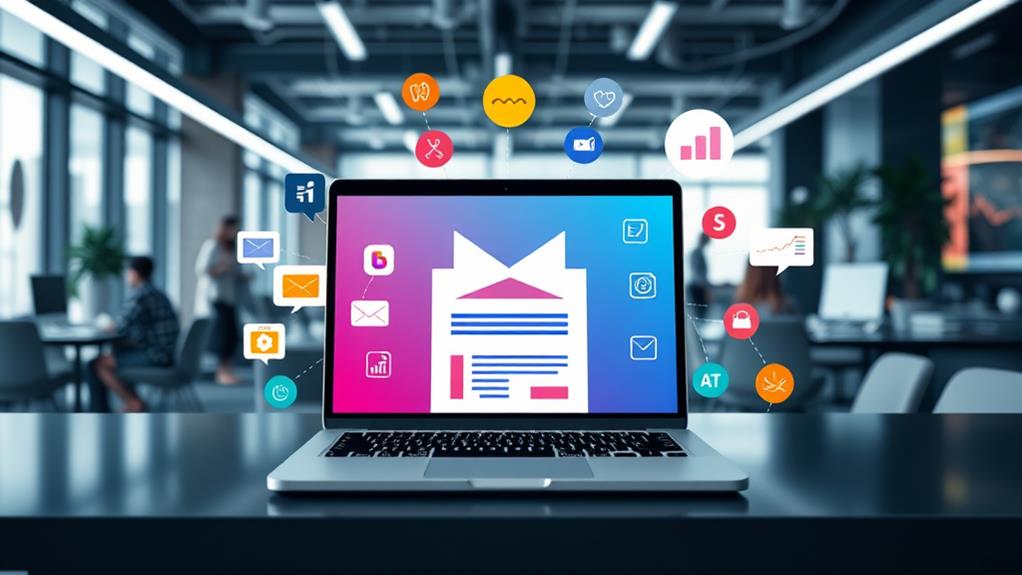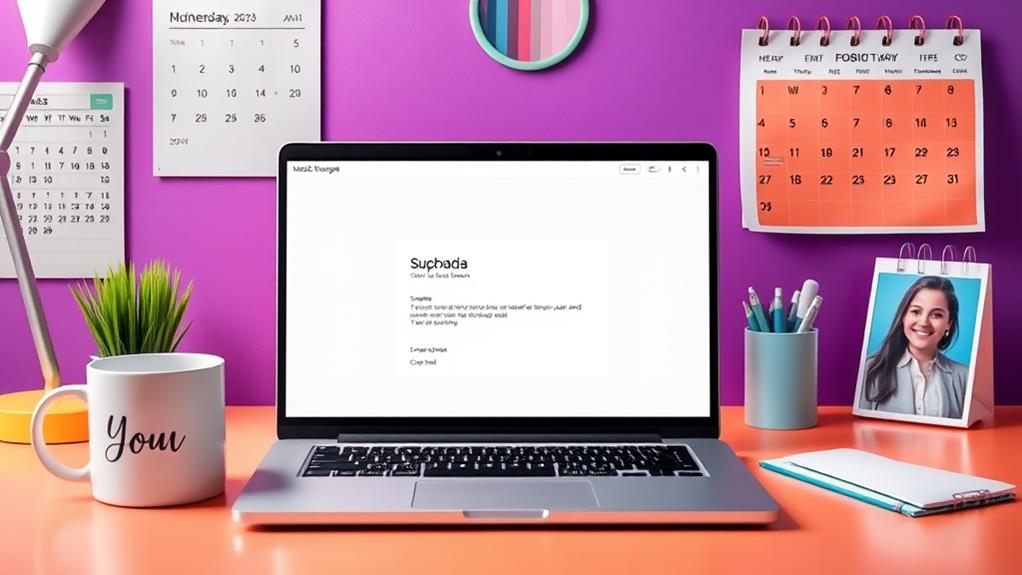Understanding the science of timing for email delivery in 2024 is essential for engaging your audience and boosting conversions. Data suggests that Tuesdays and Thursdays offer the highest visibility and revenue potential—Tuesdays for open rates exceeding 18% and Thursdays surpassing these with superior ROI. Best sending times are between 9 AM and 11 AM and 1 PM to 2 PM. Monthly trends highlight the 1st, 10th, and 30th as peak days for engagement, while audience-specific strategies reveal young consumers engaging more at night. Leveraging automation tools for precise timing further enhances campaign success. Discover more insights for superior email performance.
Key Takeaways
- Tuesdays and Thursdays are optimal for email engagement, with high open rates and conversion potential.
- Peak sending times are 9 AM to 11 AM and 1 PM to 2 PM for maximum engagement.
- Avoid sending emails late-night or early-morning due to a significant audience drop.
- B2B emails perform best on weekday mornings, particularly Tuesdays at 10 AM.
- Regular testing and audience analysis enhance email timing strategies for improved engagement.
Optimal Days for Email Engagement
Determining the ideal days for email engagement is essential for maximizing campaign effectiveness. Utilizing data-driven insights to inform timing strategies can greatly impact open rates and revenue per recipient.
Research indicates that Tuesdays and Thursdays are prime contenders for peak email engagement. With Tuesdays achieving open rates exceeding 18%, they are a reliable choice for marketers seeking high visibility. Meanwhile, Thursdays stand out with the highest revenue per recipient, making them invaluable for campaigns aimed at conversion.
Wednesdays also prove to be a strategic day for sending emails, consistently meeting open and click-through rate benchmarks. Their consistent performance makes them an ideal choice for maintaining engagement momentum throughout the week.
Conversely, Fridays, while achieving open rates above 18%, are often perceived as a "lazy" day for email consumption, suggesting that audience engagement may not be as robust compared to other weekdays.
In contrast, Saturdays register the lowest open rates at approximately 17.3%, marking them as the least effective day for email campaigns. However, Mondays, despite potential inbox congestion, can still succeed if emails are strategically sent around mid-morning, achieving open rates above 18%.
Employing these timing strategies can enhance email engagement and drive campaign success.
Peak Times for Sending Emails
Identifying the peak times to send emails can dramatically enhance engagement metrics and improve campaign success. By understanding email psychology and leveraging timing strategies, businesses can improve open rates and drive higher revenue.
Research indicates that the prime window for email delivery spans from 9 AM to 11 AM, capturing audiences as they begin their workday, ensuring messages are front and center. Additional engagement peaks occur between 1 PM and 2 PM, coinciding with post-lunch hours when recipients often check emails, and from 5 PM to 6 PM, aligning with end-of-day routines.
Tuesdays and Thursdays emerge as the most strategic days for email campaigns. Remarkably, Thursdays outperform, with revenue per recipient soaring by 33.5% compared to Tuesdays. This suggests a compelling case for marketers to prioritize Thursdays in their email strategies.
Meanwhile, Wednesdays maintain consistent performance, particularly around midday, reinforcing the value of midweek engagement.
Conversely, sending emails during late-night or early-morning hours (6 PM to 5 AM) can result in a 50% audience drop, underscoring the importance of strategic timing.
Saturdays, yielding the lowest open rates at 17.3%, should generally be avoided to prevent diminished engagement and campaign efficacy.
Monthly Email Performance Trends
Understanding monthly email performance trends is essential for marketers aiming to optimize their campaigns, as engagement rates particularly peak on the 1st and 30th, greatly boosting conversion rates.
Conversely, mid-month typically experiences a decline in engagement, likely influenced by user behavior patterns and pay schedules.
Peak Conversion Days
In the domain of email marketing, pinpointing peak conversion days is essential for optimizing campaign performance and maximizing ROI. Through meticulous timing analysis and strategic conversion strategies, marketers can capitalize on specific days that promise heightened consumer response. The 1st and 30th of the month have consistently been identified as peak conversion days, offering significant enhancements in conversion rates.
By aligning email campaigns with these dates, businesses can effectively leverage consumer readiness to engage and convert.
To enhance campaign effectiveness, consider the following:
- Clickthrough Optimization: Target campaigns on the 2nd and 26th, when clickthrough rates are at their zenith, ensuring that emails are not only opened but also acted upon.
- Open Rate Maximization: Capitalize on improved open rates by scheduling promotional emails for the 10th and 24th. This approach is designed to grab audience attention when they are most receptive.
- Strategic Targeting: Utilize the 1st and 30th to maximize the effectiveness of conversion-led campaigns. These days are strategically chosen based on consumer behavior trends, promising better ROI.
Mid-Month Engagement Decline
The phenomenon of mid-month engagement decline is a critical consideration for email marketers aiming to optimize campaign performance. Data indicates that email engagement typically wanes around the 20th of each month. This pattern is likely influenced by subscribers' mid month priorities and financial focus, as they manage pay schedules and financial commitments. Consequently, clickthrough rates drop, with the 10th and 24th showing higher engagement compared to the mid-month period.
| Date | Engagement Level | Comment |
|---|---|---|
| 10th | High | Pre-mid-month boost |
| 20th | Low | Engagement decline due to mid month priorities |
| 24th | High | Engagement rebound post mid-month |
| 1st | Peak | Start-of-month financial focus |
| 30th | Peak | End-of-month financial focus |
Strategically, marketers should adjust their email schedules to align with these trends. Minimizing email sends around the 20th can help maintain higher overall engagement by capitalizing on the more responsive periods identified at the month's start and end. Understanding these dynamics and integrating them into email strategies can lead to improved audience interaction and more efficient resource allocation. In this way, staying attuned to these monthly email performance trends is essential for maintaining robust subscriber engagement throughout the year.
Audience-Centric Timing Strategies
Implementing audience-centric timing strategies involves leveraging demographic insights to tailor email delivery times for ideal engagement.
Data indicates that young consumers are more responsive to late-night communications, whereas stay-at-home parents engage more during standard business hours.
Demographic Analysis Influences Timing
Understanding the demographic makeup of your audience is paramount when determining the ideal timing for email campaigns. Age segmentation and lifestyle alignment are critical factors in crafting a timing strategy that resonates with different audience groups.
For instance, younger demographics may engage with emails that arrive late at night, aligning with their nocturnal online habits. In contrast, stay-at-home parents might prefer communications during traditional business hours, allowing them to catch up on personal needs while managing daily family routines.
Strategically analyzing demographic data can yield the following insights for optimized email timing:
- B2B Communications: Professionals often check emails on weekday mornings, especially on Tuesday and Thursday. This schedule allows for higher engagement during times when they are most receptive to business-related content.
- B2C Campaigns: Timing is more variable, with e-commerce emails performing better on weekends or evenings, catering to leisure-focused individuals who engage during their downtime.
- Remote and Shift Workers: These groups display distinct engagement patterns, with remote workers responding more during mid-morning and shift workers preferring later send times, necessitating flexible timing strategies.
Tailoring Emails for Engagement
Building on the insights gained from demographic analysis, crafting email campaigns that align with audience-centric timing strategies can greatly boost engagement rates. Understanding audience preferences is key; younger demographics often engage more with late-night emails, whereas professionals exhibit higher engagement metrics during business hours.
This necessitates a tailored approach, where marketers align email send times with the unique schedules and routines of their audience segments. For instance, B2B communications are most effective when sent during work hours, capitalizing on the natural workflow of professionals to achieve higher open rates.
Similarly, targeting stay-at-home parents with emails during mid-morning or early afternoon aligns with their daily routines, leading to improved clickthrough rates. By leveraging these audience preferences, marketers can strategically enhance email relevance and effectiveness.
To refine these strategies, regular testing of send times is essential. Utilizing advanced email marketing tools that analyze subscriber behavior enables marketers to fine-tune their approaches, ensuring maximum engagement.
These tools provide valuable insights into the best times for specific audience segments, allowing for continuous refinement of email campaigns. Ultimately, aligning email send times with audience-centric strategies greatly enhances engagement metrics, driving overall campaign success.
Behavioral Patterns in Scheduling
Effective email marketing hinges on the strategic alignment of send times with audience behavioral patterns. Audience psychology plays an essential role in determining the ideal timing for email engagement. Understanding these patterns allows marketers to tailor their strategies for maximum impact. Here are some insights on scheduling effectiveness:
1. Audience Demographics: Different demographics exhibit distinct email engagement habits. For instance, young customers often engage more with late-night emails, while stay-at-home parents prefer emails during standard business hours. Recognizing these patterns helps in crafting personalized email schedules.
2. Lifestyle Considerations: The lifestyle of your audience greatly influences when they are most receptive to emails. Remote workers, for example, tend to check emails during flexible hours, whereas B2B audiences show heightened activity during traditional work hours, especially mid-morning.
Aligning email campaigns with these habits can greatly boost engagement.
3. Testing and Optimization: Continuous testing of different sending times is essential. Data indicates that sending B2B communications on Tuesdays around 10 AM results in ideal open rates.
Meanwhile, e-commerce promotions often see higher engagement on weekends, underscoring the importance of tailoring send times based on audience-specific habits and preferences.
Role of Automation in Email Timing
Automation plays a pivotal role in improving email timing, greatly enhancing engagement and conversion rates. By leveraging automation benefits, businesses can implement strategic scheduling strategies that guarantee emails reach subscribers at peak times, such as between 9 AM – 11 AM and 1 PM – 2 PM, leading to higher engagement. Automation tools utilize time zone delivery features, sending emails according to the recipient's local time, which greatly increases open rates by reducing the likelihood of emails being overlooked in cluttered inboxes.
Automated campaigns can also be dynamically triggered based on user actions, such as cart abandonment, allowing timely follow-ups that align with ideal engagement windows. This functionality improves conversion rates as emails are sent when users are most likely to respond positively. Additionally, advanced automation incorporates AI to analyze subscriber behavior and adjust send times dynamically, personalizing engagement to boost marketing effectiveness.
| Feature | Benefit | Outcome |
|---|---|---|
| Time Zone Delivery | Localized sending times | Increased open rates |
| Behavioral Triggers | Timely, relevant communication | Higher conversion rates |
| AI-Driven Analysis | Dynamic adjustment of send times | Enhanced personalized engagement |
Through these capabilities, automation offers precise tools for marketers to strategically enhance their email marketing outcomes.
Testing and Consistency in Scheduling
A vital aspect of successful email marketing is the strategic testing and consistency in scheduling, which guarantees that communication aligns with audience expectations and behaviors.
Consistent email scheduling fosters trust and anticipation among subscribers, encouraging them to develop habits around email consumption. By employing regular testing methods, such as A/B and multivariate testing, marketers can refine email timing strategies to enhance open and click-through rates.
These testing methods offer insights into ideal email frequency and timing, guaranteeing campaigns remain relevant and effective.
To enhance scheduling, consider the following strategic approaches:
- Analyze Historical Data: Reviewing past engagement metrics allows marketers to identify trends in audience habits, adapting email frequency and timing to match evolving preferences. This analysis is essential for maintaining engagement and enhancing campaign performance.
- Test Different Days and Times: By experimenting with various sending schedules, marketers can uncover unique audience preferences, leading to improved engagement metrics. Testing methods are vital for identifying the most effective times for email distribution.
- Monitor Engagement Metrics Continuously: Continuous monitoring guarantees that email timing strategies remain aligned with audience behavior, allowing for timely adjustments to maintain effectiveness and relevance in email campaigns.
These strategies underscore the importance of data-driven adjustments to maximize audience engagement and campaign success.
Impact of Content on Engagement
When it comes to maximizing email engagement, content quality is paramount, as it directly influences open and click-through rates. High-quality email content is instrumental in surpassing industry average open rates of 20.94%. To achieve this, content relevance is critical. Subject lines must be concise and value-driven, incorporating urgency to enhance deliverability and engagement, effectively avoiding spam filters. This strategic approach not only boosts open rates but also strengthens engagement metrics by ensuring that the email content is immediately appealing.
Furthermore, personalization through automation is a potent strategy in increasing engagement. Personalized content raises content relevance, as tailored messaging resonates more deeply with subscribers, resulting in higher click-through rates.
Regular content reviews and the removal of inactive subscribers are essential practices that maintain engagement metrics at a high level, focusing efforts on active users and enhancing overall campaign effectiveness.
Additionally, crafting content that aligns with audience interests and seasonal trends can greatly amplify conversion rates. During peak shopping periods, such as Black Friday and Cyber Monday, engaging content that captures the essence of the season can lead to marked increases in conversions, demonstrating the power of strategic content planning.
Leveraging Tools for Timing Optimization
Effective email engagement extends beyond content quality to include strategic timing, a critical component in reaching subscribers when they are most receptive. Leveraging advanced email marketing tools enhances this strategic approach through timing analytics and behavior segmentation.
Tools like MailerLite's Smart Sending utilize timing analytics to examine subscriber behavior, determining the ideal moments for dispatch, thereby maximizing engagement rates. This data-driven approach guarantees emails are presented at peak times, directly improving open and click-through rates.
Incorporating automation features further strengthens timing refinement:
- Auto-resend capabilities: By targeting subscribers who did not engage with the initial email, marketers can boost overall engagement without additional manual interventions.
- Time zone delivery: This feature guarantees emails reach subscribers according to their local time, effectively reducing the risk of sending during off-peak hours.
- Link triggers: Automation can tailor send times based on subscriber interactions, fostering timely and relevant communications.
Regular data analysis, employing platforms like Moosend, provides continuous insights to refine timing strategies. These tools not only facilitate precision in engagement but also empower marketers to adapt quickly to evolving subscriber behaviors, guaranteeing campaigns remain relevant and effective.
Frequently Asked Questions
What Is the Best Time to Send an Email on a Thursday 2024?
On Thursdays in 2024, ideal email engagement aligns with Thursday Trends, suggesting emails sent between 10 AM and 11 AM are most effective. This timing capitalizes on high open rates and maximizes strategic audience interaction and revenue potential.
What Day and Time Is Best to Send an Email?
To maximize email engagement, strategic timing based on audience insights suggests sending emails on Tuesdays between 9 AM and 11 AM. This period aligns with peak open rates, enhancing the likelihood of interaction and campaign success.
What Are the Best Days to Send Emails by Industry?
To optimize email engagement, industry trends suggest sending emails on Monday and Tuesday for B2B, Tuesday or Thursday for e-commerce, SaaS, and NGOs, and Thursday for offline retail, aligning with audience-specific peak activity times.
What Is the Best Time to Send Emails in the UK?
In the UK, ideal email open rates and peak engagement occur between 9 AM and 11 AM. These morning hours strategically capture audience attention, enhancing interaction. Additionally, emails sent between 1 PM and 2 PM also perform effectively.
Conclusion
The science of email timing in 2024 underscores the importance of strategically selecting ideal days and peak times to enhance engagement. Monthly performance trends reveal that audience-centric timing, when combined with automation, can greatly improve open and click-through rates. Consistent testing and scheduling, aligned with content relevance, further amplify engagement. Utilizing advanced tools for timing enhancement enables organizations to refine their strategies, ensuring emails reach recipients when they are most receptive, thereby maximizing the effectiveness of email marketing campaigns.




